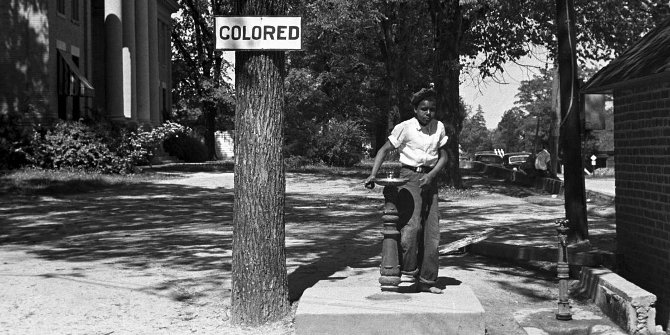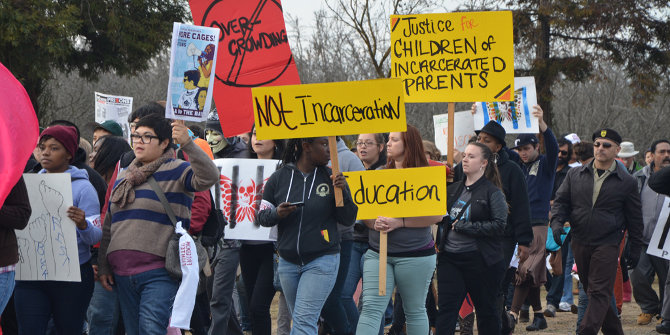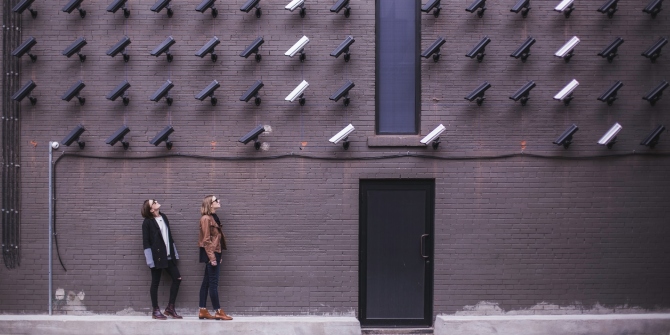 Police killings of unarmed African American men have been highly publicized and heavily debated as a horrific social problem in recent years. Michael A. Robinson writes that this social ill can be traced back to the start of the slave trade. The relationship between police and Black men reflects how the white majority has perceived Black men throughout the history of America.
Police killings of unarmed African American men have been highly publicized and heavily debated as a horrific social problem in recent years. Michael A. Robinson writes that this social ill can be traced back to the start of the slave trade. The relationship between police and Black men reflects how the white majority has perceived Black men throughout the history of America.
The death of unarmed Black men at the hands of police is not a recent phenomenon but a consequence of their historical relationship with roots in economic growth of America. This brutal exploitation and oftentimes fatal maltreatment of Blacks can be traced back as early as 1619 when the first slave ship landed in America. Because of the growth of the slave trade industry, laws were needed to govern this growing market thus giving rise to the Slave Codes. Slave patrols enforced the Codes, working only at night, riding from plantation to plantation, stopping Black people, searching their homes, and whipping any slave caught traveling without a written pass. In the early 1800s, many of the Southern states began to pass legislation granting increased authority to slave patrols with the express purpose of protecting the Southern way of life while maintaining economic stability. Moreover, Congress passed the Fugitive Slave Laws in 1793, effectively denying Blacks the basic rights that Whites enjoyed. Later, in 1864 near the end of the Civil War, the slave patrols were disbanded as slavery was abolished with the 13th Amendment.
The Rise of Urban Police Departments
The end of the slave patrols gave rise to police departments circa 1833. Police departments were springing up in most major cities to protect wealthy Americans during this time of major growth, urbanization, and civil unrest. The first American policemen were unarmed until 1858 when a New York City policeman (carrying an unauthorized pistol) shot and killed Mr. John Hollis, an unarmed Irish immigrant who posed no threat as he ran away from the policeman. Similar to recent incidents, the policeman was exonerated from any wrongdoing despite public outcry. A similar incident occurred in Boston, and shortly thereafter, police departments began arming their police force. This historical incident in New York marks the first time a newspaper reported the killing of an unarmed man by a policeman.
Black people during the reconstruction era (1865-1877) continued to be targets of laws and statutes ensuring they were kept within defined limits that were acceptable to the powerful majority. Despite emancipation from slavery, Southern legislators sought ways to creatively constrain Black people geographically to retain the Black workforce. Essentially, the Slave Codes were resurrected as the Black Codes, remaining in effect until the passing of the 14th Amendment. Still, the Jim Crow laws ushered in yet another era of White supremacy that was even more rigid and oppressive to Black people. Blacks who violated the written or unwritten Jim Crow laws increased the chances of coming into contact with a brutal police force.
Policing As a Means of Social Control
Historically, the relationship between Blacks and police has been tempestuous at best as policing was used as a means of social control and protector of the interest of the wealthy. Over-policing in the Black community has been highly debated in recent years. Police misconduct increases in communities that are economically challenged and where the residents are ethnic minorities. This is arguably the current policing strategy employed today, as the majority of Blacks still reside in poor urban over-policed areas. This is evident in the use of profiling by law enforcement of racial and ethnic minorities including driving while Black (i.e., unwarranted stops), shopping while Black, and even standing while Black, resulting in a mistrust of police. Blacks also expressed this sentiment during the slavery era and by freed Blacks as well. Furthermore, current policing tactics are not a new phenomenon but a thinly veiled reflection of policing of the past. Social media has thrust these unjust actions into mainstream America and now Americans are forced to deal with this growing social problem.
“Hey! Police Killed More White Men Than Black Men”
Let’s take a closer look at the killing of unarmed men from January 1, 2015 to December 31, 2015. According to credible news sources, there were 101 white men, 79 Black men, and 39 Latino men. The 79 killed by police represent approximately 36 percent of unarmed men killed by police yet African American males are only seven percent of the US population.
Figure 1 – Number of Unarmed Men Killed (2015)
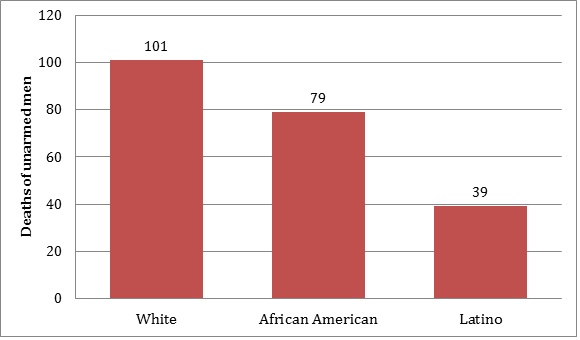
Though alarming these figures do not measure the impact of the deaths by race as accurately as in Figure 2. Clearly, African Americans were killed at higher per capita rates.
Figure 2 – Number of Unarmed Men Killed per 100,000 (2015)
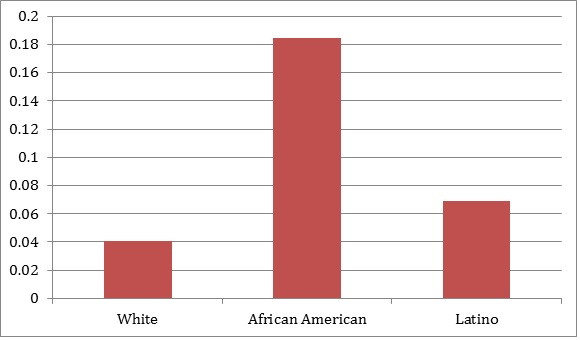
A closer look shows that unarmed Black men killed by police in 15 of the former slave holding states represent 41 percent of unarmed individuals killed by police across the US. Listed in Figure 3, are the former slaves holding states with the most homicides by police in 2015. These four states represent 27 percent of all unarmed individuals killed by police in 2015. California was not a slave holding state; however, it has the most deaths by police in 2015 at nine. Black men represent only three percent of the state’s population, but account for 20 percent of unarmed men killed by police.
Figure 3 – Former Slave Holding States with the Highest Number of Killings of Unarmed African American Men by Police in 2015.

A very sobering finding is worth noting. Maryland and Virginia are the two states that originated the slave codes and they have the highest percent of Blacks killed by police.
Unjust Killing of Black Men
The highly publicized deaths of Mike Brown, Alton Sterling, Eric Garner, and Freddie Grey are important in that they continue to bring into the media and public attention the unjust homicides of unarmed African American males by police There are others, too, such as Gregory Gunn an unarmed Black male from Montgomery Alabama; Keith Childress who was shot and killed when police in Las Vegas mistook his cell phone for a firearm; Jamar Clark, an unarmed 24 year Black male in handcuffs shot to death by Minneapolis Minnesota police officers who claimed that during a scuffle he felt Clarks hand on his weapon. Even more alarming, injustice prevails. In 2015, only ten of the policemen involved in the homicide of unarmed African American men were actually charged and of those ten officers, only two were convicted, and of those two, only one officer received jail time.
Deaths of any kind are unsettling and disturbing as the death of a loved one can disrupt a family, a community, a city, a state, and even the entire country as with the deaths of Mike Brown in Ferguson, Missouri and “Hands Up Don’t Shoot; Freddie Gray in Baltimore Maryland and “No Justice No Peace”; Eric Garner in Staten Island, New York and the “I Can’t Breathes Protest”; and the “Black Lives Matter Protest” that has become an international movement. Civil unrest resulting from actual and perceived unjust treatment by law enforcement can also lead to retaliation and death of policemen such as in Dallas and Louisiana. Civil unrest in the US as it pertains to unjust treatment of African Americans and other marginalized people can be traced back to the first recorded slave revolt in Carolina, the Stono Rebellion of 1739. If one investigates the history of uprisings and rebellions they are generally caused by the unjust treatment of a people. We should work to break that cycle before more Black lives are taken.
- This article is based on the paper, ‘Black Bodies on the Ground: Policing Disparities in the African American Community—An Analysis of Newsprint From January 1, 2015, Through December 31, 2015’ in the Journal of Black Studies.
Please read our comments policy before commenting.
Note: This article gives the views of the author, and not the position of USAPP– American Politics and Policy, nor of the London School of Economics.
Shortened URL for this post: http://bit.ly/2xX6NBe
_________________________________
About the author
 Michael A. Robinson – University of Georgia
Michael A. Robinson – University of Georgia
Michael A. Robinson, PhD, MSSW, is currently an assistant professor at the University of Georgia School of Social Work. His research interests address the wellbeing of African Americans. He also coedited a special issue of the Journal of Human Behavior in the Social Environment, which focused on the shooting of unarmed African Americans by police.


